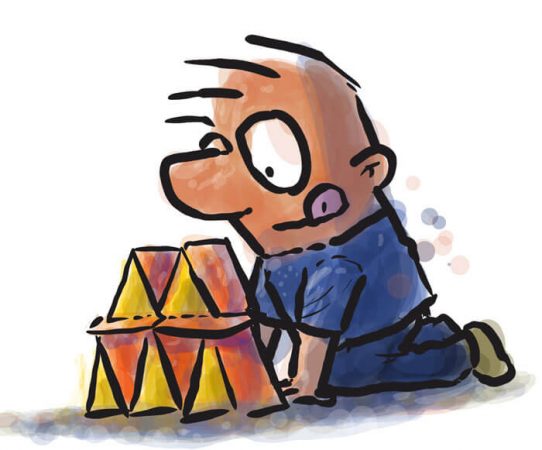Fun seems obvious as a concept.
But “fun in learning” almost seems like a bit of a paradox. What is “fun” and how can you find it, let alone use it when you're teaching a skill? Let's take a bit of a deep dive into intimidation and find how fun can save the day—yes, yet again.
Right click here and ‘save as' to download this episode to your computer.
Think of how rigidly your desks at school were placed
Now think of all the schools in almost every country, and you get the idea of conformity and rigidity. And yet if you look at a video on YouTube about the language teacher, Michel Thomas, you'll notice something quite odd. Thomas has been given what could be considered the most challenging students in the class. And his mission is to get them started on learning French. However, Michel Thomas does something entirely unexpected.
The students are clearly in a classroom, but their first task has nothing to do with learning the language
Instead they start by getting in sofas, moving screens and creating an atmosphere that's more like your lounge, rather than a room you'd find in a school. Thomas says, “learning should never be work. Instead, it should be a pleasure”.
How about we upgrade that to a bit of fun, instead?
Incredibly enough we have to define the concept of fun. Fun, at least in this context, is the opposite of intimidation. If you looked at the classroom and the desks represent intimidation, then the opposite of that scenario is fun. And the biggest reason for fun in learning is because learning itself is kind of annoying.
It starts off being very exciting, of course. If someone were to ask you if you wanted to learn how to draw, you might say yes. If you were nudged enough to believe you could dance, you might stand up unsteadily and go along. And whether you're learning to write a book, or skip your way through Photoshop, it's fun at the start, and then all hell seems to break loose.
But why is this the case?
It's because the teacher hasn't identified the intimidation factors. You know how this saga rolls out don't you? You get a course online, and it starts gamely enough. Then you tend to give up, shortly after. And people nudge you in the ribs and say, “you should make it a habit; you should persevere”.
But why did you give up in the first place? You know the answer already, don't you? If you were having fun, or if there was a nice little “carrot” at the end of the activity, you'd never need any incentive. You'd show up anyway, wouldn't you?
What about the learning and skill acquisition?
Clients are pretty smart. They know why they're headed to a workshop or a Taking Action Forum. They know the real purpose. But why does the traditional system have to be so dull, so very boring? Why does it have to be restricted to one after-event party or one meet and greet?
You can teach Photoshop at a cafe just as you can teach it in a boring environment. And that's just the starting stage for a teacher to consider. Within each course, there are fun bits and parts that intimidate the heck out of everyone. Why not look at the intimidation and see how you can make it fun?
Clients join 5000bc because they feel the loneliness of working alone. It's an online community that has many aspects to it. And one of these aspects is the “taking action forum”. You go in; you post what you're going to do, you get a buddy, and off you go. Except, not everyone was off like the wind. Some would start and then stop without warning. Why? A bit of intimidation or confusion enters their life, and it's not much fun having to report back.
But what if the reporting back was fun?
Renuka and I often discuss a lot of how we can make things more fun on our Friday coffee trips. And Renuka is slightly famous for handwritten cards and sending New Zealand chocolate. We already send out over 500 bars a year, but she suggested we create a little more fun. And here's how it went.
If anyone posted a goal in the Taking Action forum and then followed it up for a week—yes, just a week—she'd send them chocolate. Almost overnight, the Taking Action forum went slightly bananas. Was it fun to go for the reward? Of course, it was. Can you buy yourself a bar of chocolate from the corner store? Sure you can, but that's no fun, is it? Instead, you get a bar of chocolate all the way from New Zealand.
And the same sort of fun applies to workshops
If you ask clients why they're at a workshop, they often say: to learn the skill. And that's true, except for one minor point. If you announce that the workshop is going to start at 8 am and go to 8 pm, they all groan. Wait a second, wasn't that the agenda? Wasn't that the whole reason why clients were showing up to the workshop? But the moment you put them in a room with no escape, they look longingly at the EXIT sign. Working, studying, learning—that's all intimidation. The EXIT sign represents fun.
Which is why you build a workshop around the EXIT sign
You talk as little as possible and send clients out to do assignments. You get them back in the room to take stock of their progress, and off they go again. At a Psychotactics workshop, clients spend ⅔ of their time outside the room. In the Netherlands, for instance, they weren't even in the building.
They'd go for a walk for 30 minutes and come back having finished their assignment as planned. And the fun isn't just built around the workshop itself, but before and after the day is complete as well. In our Brussels workshop, everyone went on a train ride to the Tintin museum. Munich was about going to the Old Masters Museum. In Washington D.C. we went to the Smithsonian. In Vancouver, we jumped on a boat and went to across the island and had a scavenger hunt.
Yes, you read correctly. You get no points for getting it right. You get it wrong. In the info-product course, there's a section where clients have a tough time wrapping their heads around the fact that you can take any three topics, string them together and create an information product. Which is why they're given an exercise which is a whole lot of fun and try as they may, they can't get it right. In fact, everyone gets it wrong, and it's a barrel of laughs.
Which brings us to an interesting point: what do you do next as a teacher?
The first thing you need to do is make the environment as interesting as possible.
The second thing is to figure out which portions of the course are difficult, and then isolate those parts and make them fun.
The third part is not to try this all by yourself. Ask your clients how they would make it fun. You'll be surprised at the answers you get.
And this fun element isn't restricted to live training situations
Do you make videos on YouTube? Well, so does Peter McKinnon. What is the difference between him and thousands of other photographers on YouTube? He's fun. In one episode he shows the audience how to instantly wipe off the camera data immediately, then he shakes it to get the data back. At first, the audience is gobsmacked until they realise McKinnon is having a go at them. Look at the comments, and you'll see none of the hatred.
McKinnon is clearly having fun and getting his audience to follow—even while educating them. Stories on podcasts, that's fun. Cartoons in books, that's fun too. There are squillions of places you can bring fun to the table. Once again, if you don't know where you're scary, ask your audience. They'll tell you what you're doing that's intimidating and also how to fix it quickly.
This fun element also applies to your learning
All around you, you'll hear people giving you the advice to turn off your distractions. Sure, if that's getting in your way, do it. But I get a lot done, and I spend every 30 minutes on the floor. Why? Because I want to rest my back, and while I'm doing that, I'm laughing my head off. I'm watching comedy on YouTube. I'll watch Danny Bhoy, Live at the Apollo and other comedy series. From time to time, I'll head to Pinterest and check out what's popping on those screens. Twitter that I avoid, but Facebook is another place I'll go to waste time. I don't want my day to look like something out of St.Bernard's Monastery. I want to have fun.
I took that fun to my language learning as well
It's boring learning a language. Sure it's fun buying two dozen courses and using nothing, but you still can't learn a lot if you don't progress. Which is why I started putting a bunch of pictures into my language learning. And just in case you're wondering why some people learn languages faster than others, it's often for this one reason.
In fact, in a TED Talk, polygon, Lydia Machova. She loves learning languages so much that she's made it a bit of a goal (at least at this point) to learn a new language every two years. However, learning languages is no picnic in the park, which is why she set about finding why others like her learn languages. Or more precisely, what was their secret?
What did she find?
They all used different ways to learn a language. At first, there seemed to be no common thread in how people went about learning a language. However, there was one thing that they all agreed upon that sped up their learning. They all put in fun elements. I was super reluctant to learn Spanish until I discovered I could put a whole bunch of pictures. That's what makes it fun for me. For you, it might be that you like to reward yourself with New Zealand chocolate.
Which brings us to the finale of this article
Learning is largely boring, whether we like it or not. As a teacher, you have to do your due diligence (which in itself sounds boring). Find the bits that clients struggle with. How can you fix that and make it fun? As a student, Photoshop was designed to put you to sleep.
Instead of nodding through fixing a photo of some flowers in a vase, how about picking up pictures of things you like and playing with them instead? Can you get your kids to skip while teaching them? Your clients to submit their work as stick figures instead when learning to write headlines?
You know what fun looks like. Now go ahead and remove the intimidation and make it fun — both for you and your clients.
Announcing: Coming Soon! The DaVinci Cartooning Course
If you thought: “I can’t draw a straight line,” this is the course for you. That's because cartooning involves mostly wobbly lines. Plus you have a lot of fun on this course. Click here for more details



Leave a Reply